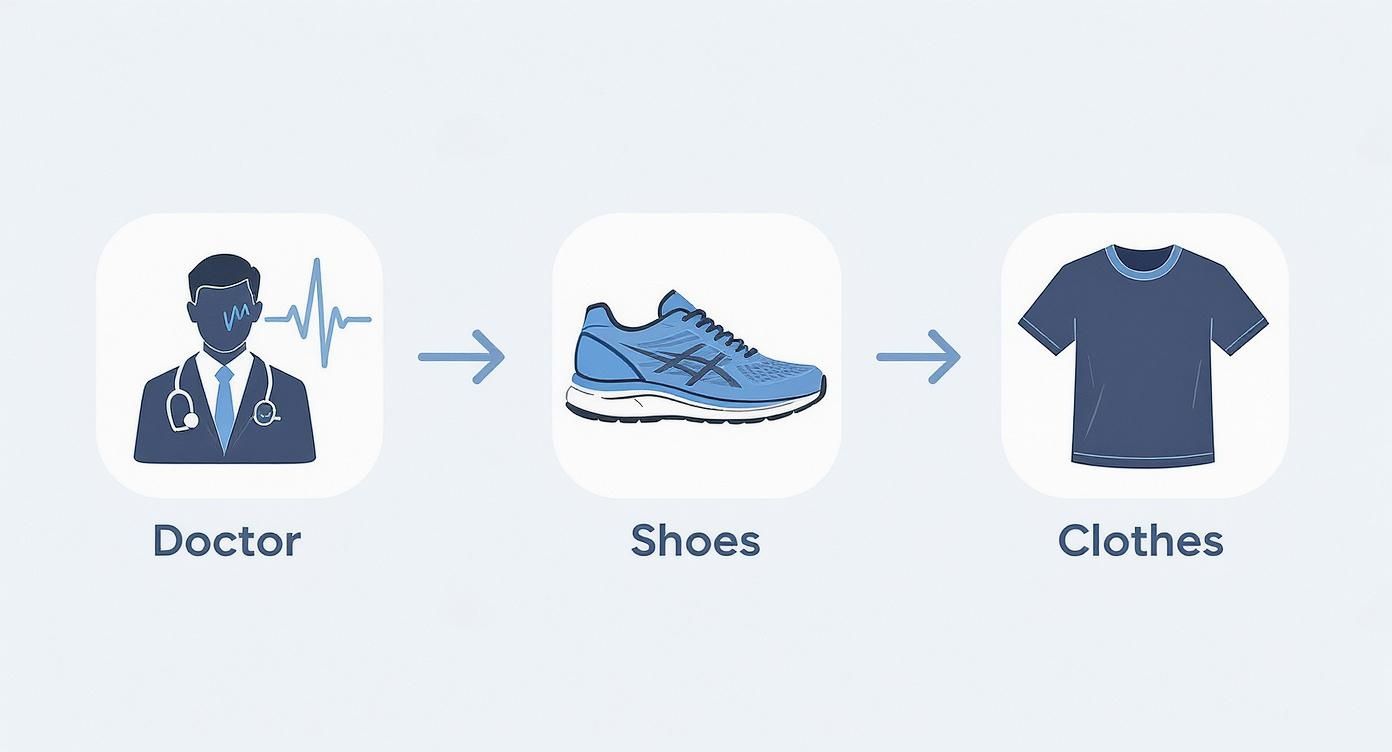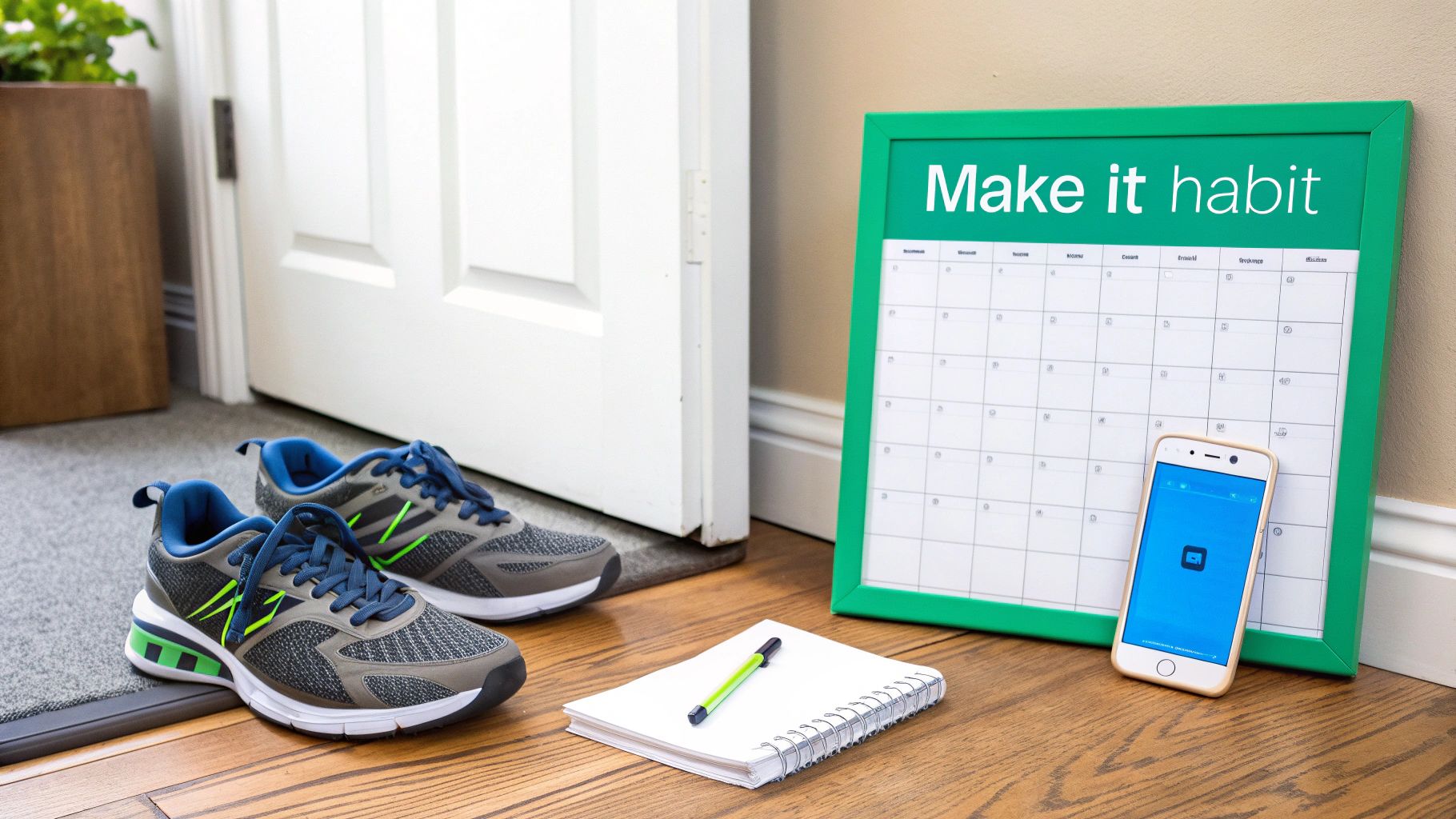So, you think you’re “not a runner”? Let’s get one thing straight right away: that’s the first myth we need to bust. Starting to run is simply about putting one foot in front of the other. It’s about tuning out everyone else's pace and focusing on your progress, finding joy in the movement, and celebrating the small wins along the way.
Why Running Is More Approachable Than Ever
If the idea of running conjures up images of elite athletes effortlessly gliding across marathon finish lines, it’s time for a mental reset. The running world has changed—a lot. It's undergone a massive, welcoming shift away from pure competition and toward community, mental well-being, and personal achievement.
The new culture of running celebrates every single step, whether it's your first jog around the block or your first 5K.

This isn’t just a vibe shift; it’s a real cultural movement. The post-pandemic era, in particular, completely reshaped the sport into something far more inclusive and accessible for everyone.
A New Era for Runners
When the world shut down, millions of people rediscovered the simple freedom of moving outdoors. This sparked a running renaissance, and the numbers are truly staggering. Marathon finishers in the United States, for example, bounced back from a low of 142,590 in 2020 to 432,562 in 2024—a figure that now blows past pre-pandemic levels.
What’s even more telling is that over half of new runners are opting for casual jogs and charity events instead of traditional races. The focus has clearly shifted from speed to experience. You can dig into these encouraging trends in this full report on U.S. marathons.
This incredible growth means you're not starting this journey alone. You’re joining a massive, supportive global community.
Running is no longer just for the super-fit. It’s for the parent who needs 30 minutes of quiet time, the student trying to manage stress, and anyone who just wants to feel a little stronger—both physically and mentally.
Redefining What It Means to Be a Runner
The best part about learning to run today is that you get to define what success looks like. There are no prerequisites. No time trials. The only real requirement is the desire to give it a try.
Here’s a quick look at the core benefits that draw so many people to the sport.
Top Reasons to Begin Your Running Journey Today
| Benefit Category | Why It Matters for Beginners | What You Can Expect |
|---|---|---|
| Physical Health | It’s one of the most efficient ways to improve cardiovascular fitness, manage weight, and build stronger bones. No fancy equipment needed. | Feeling more energetic in daily life, better sleep, and a stronger heart. You might even notice your clothes fitting a little differently. |
| Mental Clarity | Running offers a powerful escape from daily stressors. The rhythmic motion can be meditative, helping to clear your head and boost your mood. | A noticeable reduction in stress and anxiety. Many runners experience a "runner's high"—a feeling of euphoria and calm after a good run. |
| Social Connection | Whether you join a local club, a parkrun, or a virtual community, running is a fantastic way to meet like-minded people. | Making new friends, finding accountability partners, and feeling part of a positive, encouraging community. |
This shift in focus has really changed the game for beginners. Today's running culture is built on a few simple, powerful principles:
- Consistency over Intensity: Just showing up for a 15-minute walk-run is a much bigger win than pushing too hard, getting injured, and being stuck on the couch.
- Celebrating Personal Progress: That first continuous mile? It's a monumental achievement. Celebrate it!
- Community over Competition: From local clubs to virtual groups, the modern running world is built on encouragement, not just winning medals.
- Mental Health First: For so many of us, the mental clarity and stress relief from a run are far more valuable than any number on a watch.
Think of this guide as your personal roadmap to joining this movement. It’s not about becoming an elite athlete overnight. It’s about feeling good, building confidence, and discovering the simple power of lacing up your shoes and heading out the door.
The Only Gear You Actually Need to Start
It’s easy to get overwhelmed by the sheer amount of running gear out there. But I’ll let you in on a little secret most experienced runners know: you don’t need much to get started. Before you drop a ton of cash on fancy gadgets and high-tech outfits, let's nail down the absolute essentials that will keep you comfortable and, most importantly, injury-free.
But first, a quick and important note on your health. If you have any pre-existing health issues, are brand new to exercise, or just have some concerns, it's always a good idea to have a quick chat with your doctor before diving in. A simple check-in can give you the peace of mind to know you're starting off on the right foot—literally.
Finding Your Perfect Running Shoes
If you're going to invest in one thing, make it your shoes. Those old sneakers you use for mowing the lawn might feel fine for walking around, but they just aren't built for the repetitive impact of running. Wearing the wrong shoes is a fast track to common beginner pains like shin splints and sore knees.
Your best bet? Head to a specialty running store. Don't be intimidated! The staff are usually runners themselves and genuinely love helping newcomers. They’ll likely have you walk or jog on a treadmill for a moment to analyze your gait—which is just the fancy term for how your foot strikes the ground.
This little analysis is a game-changer. It helps them recommend a shoe that matches your body's specific needs, like whether your foot rolls inward or needs a bit more cushion. For example, if you have specific foot issues, understanding your mechanics is crucial. Getting the right support from day one can make all the difference, and you can learn more about finding the best running shoes for flat feet to see just how specific that support can be.
Your running shoes are your single most important piece of equipment. They're the foundation for your comfort and injury prevention. Don't guess—get a proper fitting.
Why Your Clothing Choices Matter
Beyond your feet, what you wear can make or break your run. You don’t need a whole new wardrobe, but you do need to pick fabrics that work with your body, not against it.
The golden rule of running clothes is simple: avoid cotton at all costs. Seriously. Cotton is fantastic for lounging, but the second it gets sweaty, it stays wet, heavy, and clingy. This is a recipe for miserable, soggy runs and can lead to painful chafing and blisters.
Instead, look for technical fabrics made to handle sweat. Here’s a quick rundown of what to look for:
- Moisture-Wicking Tops and Bottoms: Grab shirts, shorts, or tights made from synthetic materials like polyester or nylon blends. These fabrics pull sweat away from your skin to the outer layer of the clothing so it can evaporate, keeping you much drier and more comfortable.
- Performance Socks: Just like your shirt, ditch the cotton socks. A good pair of running socks made from a wool or synthetic blend is your best defense against blisters. They add a bit of cushion where you need it and, most importantly, keep your feet from getting swampy.
That's really it. A solid pair of shoes, some good socks, and a comfortable, non-cotton outfit are all you truly need to start. As you get more into it, you might want to explore things like GPS watches or hydration packs, but for now, this simple setup is more than enough to get you out the door.
Your Simple Walk-to-Run Training Plan
Alright, this is where the rubber meets the road. We're moving past the prep work and getting into a real, actionable training plan that will build you into a runner, safely and sustainably. The idea isn't to throw you into the deep end; it’s all about easing your body into the new demands of running. That's the secret to sticking with it and avoiding injury.
The heart of this approach is the run-walk method. It's a tried-and-true strategy that does exactly what it says: you alternate between short bursts of running and periods of walking. This is brilliant because it lets you build your cardio fitness and strengthen your muscles without that crushing fatigue that makes so many beginners quit.
Think of it this way: your body is learning a brand new language. You wouldn't expect to be fluent on day one, right? Same thing here. The walking breaks are your recovery, letting your heart rate settle and your muscles recharge before you go again.
This infographic sums up the simple essentials we've covered to get you to the starting line, feeling ready.

It’s a great visual reminder of the basics: get the all-clear from your doctor, grab the right shoes, and pick out some comfy clothes. Nailing these fundamentals sets you up for a much smoother journey.
Your Warm-Up and Cool-Down Routine
Before you even think about starting your first run-walk interval, you need to bookend every single workout with a warm-up and a cool-down. These aren't just suggestions—they are non-negotiable. I can't stress this enough; they're absolutely critical for preventing injuries and helping you recover.
A solid warm-up gets the blood flowing to your muscles, raises your body temperature, and preps your joints for the impact ahead. Forget about that old-school advice to hold a hamstring stretch for 30 seconds. Before a run, you want dynamic movements that mimic running.
Your 5-Minute Pre-Run Warm-Up
- Leg Swings: Find a wall or fence for balance. Swing one leg forward and back, then side to side. Do this for 30 seconds per leg.
- High Knees: Jog lightly in place, focusing on bringing your knees up toward your chest for 30 seconds.
- Butt Kicks: Again, jogging in place, try to kick your heels back toward your glutes for 30 seconds.
- Walking Lunges: Take a big step forward and lunge, keeping your front knee over your ankle. Aim for 6-8 reps per leg.
- Arm Circles: Make big circles forward and backward with your arms for about 30 seconds.
Once you've finished your workout, the cool-down is your body's off-ramp. It brings your heart rate down gradually and can make a huge difference in how sore you feel the next day. Now is the time for those classic static stretches.
Your 5-Minute Post-Run Cool-Down
- Hamstring Stretch: Sit down, extend one leg straight, and bend the other. Gently lean forward over the straight leg. Hold for 20-30 seconds on each side.
- Quad Stretch: Stand up and hold onto something for support. Grab an ankle and gently pull your heel toward your glute. Hold for 20-30 seconds per leg.
- Calf Stretch: Face a wall and place your hands on it. Step one foot back, keeping that leg straight and your heel planted on the ground. You should feel a stretch in your calf. Hold for 20-30 seconds per leg.
Choosing Your Walk-to-Run Plan
Now for the main event. Below you’ll find an 8-week plan that’s a fantastic starting point for most people. The number one rule? Listen to your body. If a particular week feels like a struggle, just repeat it. Seriously, there's no prize for rushing. Consistency is what builds a runner, not speed.
This schedule assumes you'll be working out three times a week on non-consecutive days (like a Monday, Wednesday, Friday schedule). That rest day in between is crucial—it's when your body repairs itself and gets stronger.
Remember, the workout times in the plan don't include your warm-up and cool-down. Always add a 5-minute warm-up before and a 5-minute cool-down after every single session.
If you're looking for even more options, our guide on creating a running schedule for beginners dives deeper into structuring your first few weeks.
Sample 8-Week Walk-to-Run Progression Plan
This table is your roadmap for the next two months. The structure is simple: for each week, you'll perform the same workout on your two or three training days. For example, during Week 1, every workout consists of repeating the "Run 1 min, Walk 4 min" cycle.
| Week | Workout Day 1 | Workout Day 2 | Workout Day 3 (Optional) |
|---|---|---|---|
| Week 1 | Run 1 min, Walk 4 min (Repeat 5x) | Run 1 min, Walk 4 min (Repeat 5x) | Run 1 min, Walk 4 min (Repeat 5x) |
| Week 2 | Run 2 min, Walk 3 min (Repeat 5x) | Run 2 min, Walk 3 min (Repeat 5x) | Run 2 min, Walk 3 min (Repeat 5x) |
| Week 3 | Run 3 min, Walk 2 min (Repeat 5x) | Run 3 min, Walk 2 min (Repeat 5x) | Run 3 min, Walk 2 min (Repeat 5x) |
| Week 4 | Run 5 min, Walk 3 min (Repeat 4x) | Run 5 min, Walk 3 min (Repeat 4x) | Run 5 min, Walk 3 min (Repeat 4x) |
| Week 5 | Run 7 min, Walk 2 min (Repeat 3x) | Run 7 min, Walk 2 min (Repeat 3x) | Run 7 min, Walk 2 min (Repeat 3x) |
| Week 6 | Run 10 min, Walk 2 min (Repeat 2x) | Run 10 min, Walk 2 min (Repeat 2x) | Run 12 min, Walk 2 min (Repeat 2x) |
| Week 7 | Run 15 min, Walk 1 min (Repeat 2x) | Run 15 min, Walk 1 min (Repeat 2x) | Run 18 min continuous |
| Week 8 | Run 20 min continuous | Run 22 min continuous | Run 25 min continuous |
By the time you finish this program, you will have built the strength and stamina to run for over 20 minutes straight—a massive accomplishment. Trust the process. Some days will feel amazing, others will be a grind. The most important thing you can do is just keep lacing up your shoes and getting out the door.
How to Pace Yourself and Avoid Common Injuries
Alright, you've got your shoes, a plan in hand, and you’re fired up to hit the road. But let’s talk about two hurdles that trip up almost every new runner: going out way too fast and getting sidelined by a totally preventable injury.
Nailing your pacing and learning to listen to your body aren't just good ideas—they are the absolute keys to enjoying this and sticking with it for the long haul.
The single biggest mistake I see beginners make is trying to run too hard, too soon. It’s a natural instinct! You feel that first burst of energy and just want to go for it. But that approach almost always leads to burnout, exhaustion, and that dreaded feeling that you're just "not a runner."
Let me be clear: the goal of your first few weeks isn't speed. It's consistency.
Finding Your Conversational Pace
So, how fast should you actually be running? The answer is way simpler than you think and doesn't require any fancy tech. The best tool you have is the talk test.
It’s exactly what it sounds like: you should be able to hold a conversation while you're running.
If you can chat in full sentences without gasping for air, you’ve found a great, sustainable pace. If you can only spit out one or two words at a time, you need to slow down. It might feel surprisingly slow at first, and that’s perfectly okay. This is your body building its foundation.
This "conversational" effort is what builds your aerobic base. Think of it as the foundation of your entire running fitness. It teaches your body to get better and more efficient at using oxygen, which is exactly what will allow you to run longer and feel stronger down the road.
Using the Rate of Perceived Exertion (RPE)
Another fantastic, low-tech tool is the Rate of Perceived Exertion (RPE) scale. It’s just a simple 1-10 scale where you rank how hard an effort feels to you. This is your personal dial, helping you tune into what your body is telling you.
Here’s a simplified breakdown for beginners:
- RPE 1-2: Super light activity, like a casual walk around the block.
- RPE 3-4: A light effort. Your breathing is a little heavier, but you could talk all day. This is a great warm-up or cool-down zone.
- RPE 5-6: Your conversational pace. You can still talk, but someone on the phone would know you're exercising. This is your sweet spot for most of your runs.
- RPE 7-8: Getting tough. You can only manage short phrases.
- RPE 9-10: An all-out sprint. You can’t talk. Steer clear of this for now.
For your walk/run intervals, aim to keep the running portions in that RPE 5-6 zone. It’s the magic spot for building endurance without putting your body under too much stress.
The Golden Rules of Injury Prevention
As you start running, your muscles, tendons, and bones need time to adapt to the new stress. Most common running pains, like shin splints or runner's knee, pop up when we ask our bodies to do too much, too soon.
The good news? Most of these are completely preventable. Your best defense is simply listening to your body and respecting its limits.
Pain is not a badge of honor in running. It's your body's warning signal. A little muscle soreness after a workout is normal, but sharp, persistent, or worsening pain is a clear sign to back off and rest.
To stay healthy and on your feet, lock in these three principles:
- Respect Your Rest Days: Rest days are non-negotiable. Seriously. This is when your body actually does the hard work of repairing and rebuilding itself stronger. Skipping rest is one of the fastest tickets to an injury.
- The 10% Rule: Once you're running consistently, try not to increase your total weekly mileage by more than 10% at a time. This gradual progression gives your body the time it needs to adapt without getting overloaded.
- Don't Ignore Your Form: You don't need to look like an Olympian, but a few simple cues can make a world of difference. Try to "run tall" with your chest up and shoulders relaxed. Aim for a light, quick foot-strike that lands underneath your body, not way out in front of it.
Remember, the real goal is to enjoy the journey. The running world is becoming more welcoming than ever—while elite marathoners are getting faster, the average race times for most distances were actually slower in 2023 than a decade ago. This tells us that more and more people are running for personal fulfillment, not just a time on a clock.
As you start out, know that you’re part of a movement about finding the pace and community that fits your life. If you're curious, you can find more insights on how running is evolving for everyone.
Making It a Habit That Actually Sticks
Let's be honest. Motivation is what gets you to buy the shoes, but it's a terrible long-term strategy. It's flaky. It disappears the second your alarm goes off on a cold, rainy morning.
Habits, on the other hand, are what get you out the door when motivation has called in sick. Building a real, lasting running habit isn't about brute force or willpower. It’s about being smart and using a bit of psychology to make running an automatic part of your day, just like brewing your morning coffee.

Design Your Environment for Success
The single biggest secret to building a habit is to make it ridiculously easy to start. You want to remove every possible bit of friction between thinking "I should run" and actually being out on the pavement. Instead of waiting for a lightning bolt of inspiration, you just rig the game in your favor.
Think about all the tiny decisions that stand between you and a run. What should I wear? Where are my socks? When do I have time? Each one is a potential excuse. Your job is to eliminate them beforehand.
- Lay Out Your Gear: This is non-negotiable, especially for morning runs. The night before, put out your shirt, shorts, socks, and shoes. When you wake up, there’s no thinking involved. You just get dressed and go.
- Schedule It Like an Appointment: "I'll run tomorrow" is a wish, not a plan. Block it out in your calendar. A vague intention is easy to ignore, but a scheduled 30-minute run at 7:00 AM feels like a real commitment you’re less likely to blow off.
- Pick a Consistent Time: Your body and brain love routine. Running at the same time every day signals that this is just part of the daily rhythm, not some optional activity you have to find energy for.
Redefine Your Goals and Celebrate the Wins
So many new runners quit because they fixate on a huge, intimidating goal from day one. If you can barely run for a minute, thinking about a marathon is just going to make you feel defeated. The trick is to stop focusing on the outcome and start focusing on the process.
Instead of a goal like "run a 5K," try a process-based goal like "get my running shoes on and get out the door three times this week." That's it. You're focusing on the one thing you can actually control: showing up.
The most important mental shift is to celebrate the act of starting. Finishing the workout is a bonus. The real victory was putting on your shoes and heading out the door. That’s the habit.
And I mean really celebrate it. Finished Week 1 of your plan? That's a huge deal! Acknowledging these small wins gives your brain a little hit of dopamine, the feel-good chemical that reinforces this new habit and makes you want to do it again.
Leverage the Power of Accountability
Trying to do this all by yourself is tough. We’re social creatures, and we are way more likely to follow through when other people are involved. Bringing in a little accountability might be the most powerful tool you have.
- Find Your People: Join a local running club, find a supportive group on Facebook, or connect with friends on an app like Strava. Just seeing that other people are getting their runs in can be incredibly motivating.
- Tell Someone Your Plan: This one is almost too simple, but it works. Tell a friend or partner your goal for the week. Knowing someone might ask, "Hey, how was your run today?" is often the exact push you need to get moving.
- Reframe the Mental Game: Finally, you have to work on your inner voice. On those days when it feels like a slog, it's easy to think of running as a punishment. Try to flip that script. This is your time. It’s a privilege to be able to move your body and clear your head.
Some runs will feel incredible. Others will be a grind. That’s just running. The goal isn’t to have a perfect run every single time. The goal is to become the kind of person who runs, even when it’s hard. That’s how you turn a simple action into a habit that can genuinely change your life.
Answering Your Biggest Questions as a New Runner
As you get into the swing of running, you'll find a dozen new questions pop up every week. That's a good thing! It means you're engaged and thinking about your progress. Let’s tackle some of the most common hurdles and queries that every new runner faces.
How Many Days a Week Should I Actually Run?
When you first catch the running bug, it's tempting to want to lace up every single day. But hold on—rest is where the real magic happens. For anyone just starting out, three non-consecutive days per week is the sweet spot.
A Monday-Wednesday-Friday schedule, for example, gives your body a full day to recover and adapt between workouts. That downtime is when your muscles, joints, and ligaments actually rebuild stronger. Pushing for more days too soon is one of the fastest ways to get injured or just plain burn out.
Is It Better to Run on a Treadmill or Outside?
This is the classic debate, and honestly, the answer is simple: the best place to run is wherever you'll actually do it consistently. Both have their perks, and your choice will likely come down to weather, convenience, or just what you're in the mood for.
The Case for the Treadmill
- Total Control: No worrying about icy sidewalks, pouring rain, or scorching heat.
- A Softer Landing: The cushioned belt is definitely gentler on your joints than hard pavement, which is a big plus as your body adapts.
- Easy Pacing: You can lock in a specific speed and learn what a consistent pace feels like.
- The Downside: Let's be real, it can get boring. There's a reason people call it the "dreadmill."
The Case for Running Outdoors
- Way More Engaging: Fresh air and changing scenery make the miles fly by and feel less like a chore.
- Builds Real-World Strength: Uneven surfaces and wind resistance force you to use smaller stabilizing muscles you'd miss on a machine.
- Race Day Prep: If you have a 5K on the horizon, training outside gets you ready for the real deal.
- The Downside: You're at the mercy of the weather, daylight, and road conditions.
My two cents? Mix it up if you can. Hit the treadmill when the weather's awful or you're short on time, but try to get outside at least once a week. The mental boost from running in nature is huge.
What on Earth Should I Eat Before a Run?
Fueling can make or break a run, but you don't need to overthink it at this stage. The goal is simple: give your body some easily digestible carbohydrates for energy without upsetting your stomach.
If you’re running for under an hour, a small snack about 30-60 minutes beforehand is perfect. Think simple carbs, and steer clear of anything high in fat, fiber, or protein right before you head out—those take way too long to digest.
A few go-to pre-run snacks:
- Half a banana
- A piece of toast with a little jam
- A small handful of pretzels or plain crackers
Once your runs get longer and you start thinking about bigger goals, you'll dive deeper into fueling. If you're already dreaming about what's next, our guide on how many miles are in a half marathon can give you a peek at what that next level looks like.
How Do I Get Rid of This Awful Side Stitch?
Ah, the dreaded side stitch. That sharp, stabbing pain in your side can stop you in your tracks. It’s incredibly common for beginners and is usually tied to your breathing patterns causing your diaphragm to spasm.
The next time you feel one coming on, try this:
- Slow Down: The first step is always to slow down to a walk. Don't try to power through it.
- Breathe from Your Belly: Take slow, deep breaths, focusing on expanding your stomach, not your chest.
- Press and Stretch: Gently press your fingers into the spot that hurts while you exhale slowly. You can also try reaching the arm on the same side as the stitch straight up overhead to give the muscle a good stretch.
To prevent them in the first place, work on deep, rhythmic belly breathing during your runs. Also, try to avoid eating a big meal within two hours of heading out the door.
At THE RUNNING, we believe everyone can be a runner. Our mission is to provide you with the expert training plans, gear reviews, and motivational tips you need to achieve your goals, one step at a time. Discover your running potential with us.








